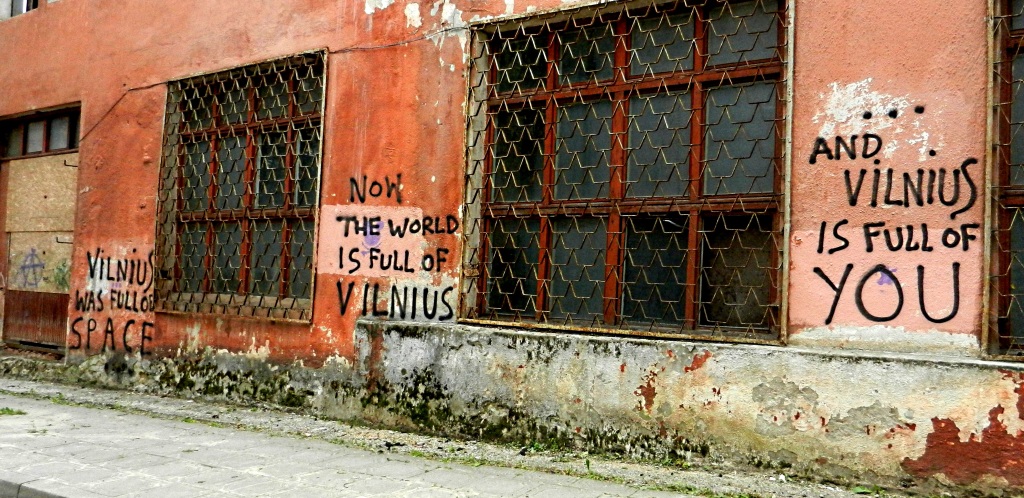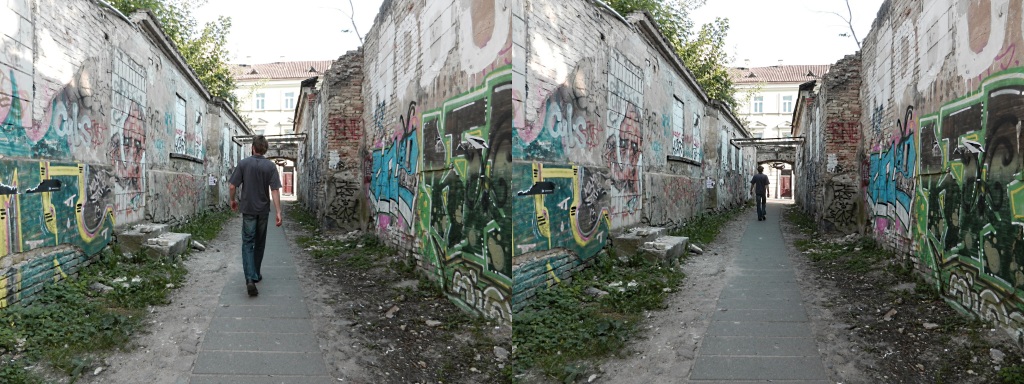
Early in the morning we bid a sad farewell to Ola and John, our most gracious Workaway hosts in northern Poland, and prepared ourselves for the two week tour ahead that would swiftly sweep us into the unknown. The Baltic Nations, three post-USSR countries sandwiched between Russia and the Baltic Sea, were completely unfamiliar to us and we relished the chance to discover its mysteries first-hand. First on the list: Vilnius.

It was only a short bus ride from the Polish/Lithuanian border to the capital city of Vilnius. Upon entering we were greeted with a strange mixture of debilitated buildings and historical wonders. Sweating profusely in the midday sun whilst shouldering cumbersome backpacks of non-essentials, we tottered along a confusing highway, stumbled down a cobblestone path into a patch of woods, awkwardly asked a native Lietuvis for directions, and at last found our place: The Downtown Forest Hostel. So what if it only got two stars on Trip Advisor? The building was pretty rad– decorated with rubber plants and fake trees, and if you had a tent you could pitch it right in their yard! There was a fridge downstairs stocked full of cheap beer and the staff was incredibly friendly… maybe too friendly? We were led up a few flights of stairs and, releasing the burden from our soggy backs, we harmoniously collapsed into our silken beds. Above our heads, seated cutely upon the pillow, was a tiny scroll wrapped in hemp. We unrolled the paper, and read:
Dear Guest!
If you are reading this letter, you are in your bed. From some kind of view, both of us are in one bed. That’s a bit strange, but from this very moment we can communicate to each other in a totally different way, c’mon — we will spend a night together.
The letter continued on in an uncomfortably intimate tone, but we were pleased to know that the staff was there to provide for our every need. Laughing nervously to ourselves, we quietly snuck outside and began to explore Vilnius: city of… Churches?
Yes, an unbelievable amount of churches: 42 within the city limits, and all with their own especially creative names. Some of these include: Church of the Holy Cross, Church of the Holy Spirit, Orthodox Church of the Holy Spirit, Church of the Holy Mother of God, Church of the Apparition of the Holy Mother of God… are we beginning to see a pattern?
As repetitive as their names may be, the colours and design of each chapel were surprisingly unique. We passed by many, stopping only to admire each church for a few moments before carrying on our way. There was too much to see with so little time! Some of our favourites included the Orthodox Church of the Holy Spirit, its interior bursting with rich blue and green colours, and Bernardine Church, a colossal, red-brick gothic-style structure built to withstand a siege.
The Orthodox Church of St. Paraskeva was the smallest chapel we’ve ever seen but displayed a richness in colour and embellishment. Churches have been burnt down and rebuilt on this site for centuries (at least four times) and the oldest, according to legend, was a pagan temple of Ragutis. Leave it to the Lithuanians to invent a god of beer, vodka, and mead; Ragutis must have had a huge following. You could imagine that his temple would have been more like the local villager’s favourite pub, and the act of worship was all about getting completely wasted.
The Gate of Dawn, one of Vilnius’ top-ten tourist attractions, was originally built as part of the city wall guarding the southern entrance and is the only remaining gateway of nine. The name “Dawn” comes from the mystical painting of the Virgin Mary, “Our Lady: the Morning Star”, an icon that hangs in the chapel of the gatehouse. It is said that the painting has miraculous healing powers for one who passes through the gate and says the prayer:
O my Mother, the Blessed Virgin Mary, I offer myself entirely to Thy grace and to Thy overwhelming mercy today and forever, but mostly at the hour of my death do I dedicate myself to thee. To thee do I dedicate my body and soul, all my happiness and hope, all my sorrows and sufferings! I offer my life and the end of my life to Thy holy hands so that through Thy merits all my deeds and acts go according to Thy holy will and according to the will of Thy sweetest Son! Amen.
The painting of the Virgin Mary is also famed as a “Black Madonna“, depicted with dark skin, one of the 500 found throughout Europe. While visiting The Gate of Dawn we witnessed several believers kneeling and praying to “Our Lady of Mercy” as church bells rang overhead.
Amidst our vagrant wanderings through the cobblestone streets of Vilnius, we stumbled upon a pint-sized country. On April 1st, 1997, the neighbourhood of Užupis declared its independence as a sovereign nation, electing their own president, creating their own flag, and writing their own constitution (not to mention their 11-man army). Copies of the 39 articles of the Republic’s constitution and 3 mottos – “Don’t Fight”, “Don’t Win”, “Don’t Surrender” – in fifteen languages, can be found affixed to a wall on Paupio street in the area. Several of these constitutional laws include cats and dogs as citizens, for example: “A cat is not obliged to love its owner but must help in time of need”; and, “A dog has the right to be a dog”.
Užupis is quite small, only 148 acres with 7000 inhabitants, and most of them are artists. They are responsible for a vast array of sculptures, murals, and general weirdness scattered around the city– including a statue of Frank Zappa! We’re not sure whether The Republic of Užupis began as a sheer mockery, an experiment, or just as a deviation from the norm, but it certainly was a fascinating and humorous break from the historical church scene in Vilnius’ Old Town. It reminded me of our visit to Freetown Christiania in Copenhagen (though lacking the distinct smell of skunk-weed).
Within the Užupis district we also visited one of the three oldest graveyards in Vilnius: Bernardine Cemetery, and I have to say I really enjoyed it. No, not because it was full of dead people. I could have explored this huge cemetery (14 000 burial sites) for hours, winding down thin, twisting pathways among colossal sculptures of angels and simple iron crosses. Some graves were well tended with miniature plots of flowers but most were completely overgrown with giant ferns, moss and fallen trees. The people had let nature take over… this graveyard had become a forgotten garden, a sanctuary, and it was beautiful.
There is a monument of three white crosses, visible from most parts of Vilnius’city centre, up on Crooked Hill in Kalnai Park. It is said that they are a monument to seven Franciscan monks who, in the 14th century, travelled to Vilnius to preach Christianity. Some of the townspeople didn’t want these holy men preaching in their homeland, so they captured, cruelly tortured and murdered the monks. When the Grand Duke Algirdas (ruler of Lithuania) found out, he punished those responsible and erected three wooden crosses on Crooked Hill to commemorate their tragic deaths. In time, the wooden crosses collapsed and were nearly forgotten. In 1916 a new, concrete monument was erected, only to be blown up under the order of the Soviet Government in 1950. At last, to celebrate Lithuanian independence in 1989, a set of three crosses were raised anew and are what you see standing today.
It was a steep climb to the top of Crooked Hill, but the panoramic view of Vilnius was worth it. The whole of Vilnius stretched before us, the red-roofed old town below with its church steeples standing tall, trying to look pretty. I took a moment to soak it all in, to keep my memories of the place alive. In only a few days we attempted to sift through thousands of years of Lithuania’s history, culture and traditions. As a mere tourist I know that we haven’t even scratched the surface and I wish we had more time to explore, but I’m still happy to have experienced a small part of Lithuania first-hand.